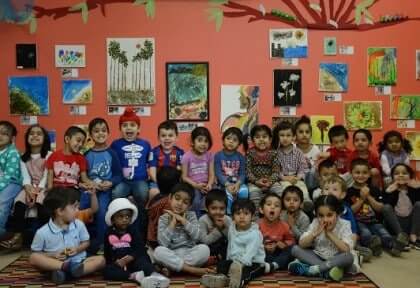A unique artistic concept combines environmental sustainability with kids’ creativity
Kids under six, juices of crushed leaves and fruits, dried spices, onion peels, pine needles and white canvases… sounds like a recipe for mayhem! Wait before you jump to that conclusion. If directed and channelled properly, this can create a great environment that will get the children’s creative juices of flowing. This is what was demonstrated by a recent painting exhibition at Cuddlez Montessori, a long day care centre in Quakers Hill.

What made this art exhibition special was the concept behind it. Only natural colours and natural materials were used to produce the artworks on display. The initiative was not just about introducing the value of products and physical materials from the natural world to the children, it was also an awareness campaign towards eradicating the harmful materials used in paints in various domains. As a flow-on effect, the exercise was meant to promote sustainable living among the families of the children attending the centre and also the wider community.

Since most of the children and educators at the institution are of Indian background, Indian spices were chosen as the raw materials at large, along with many other natural resources. Pre-soaked rice grains, cornflour, glue and warm water were used to make the base of the paint and different spices and juices were added to create colour. Other everyday items like onion peel, garlic peel, bark, coffee beans, tea leaves, shells, sand, clay, cinnamon, bay leaves, bottle brush flowers, coconut shell, husk pith and charcoal were also used to embellish the art work. (The materials used to produce the respective colours are given in the table).

Nandan Mukhariya, the nominated supervisor of the centre, spoke to Indian Link about why painting was the chosen medium for this venture.
“Creative activities like painting help the brain develop. The right side of the brain is used for emotional and creative responses, while the left side of the brain focuses on analytical processes and logic. Learning to paint benefits children by using both sides of their brain,” Nandan explained.

The Centre sought to bring out the young children’s instincts through the arts and encourage them to learn through their own initiative.
“This venture is an effort to channel the interest of young children towards appreciating the environment, the importance of which is being overlooked by people these days. We are aiming to promote awareness about nature amongst the younger generation,” Nandan said.

Themed ‘Dialogue with Nature’, this exhibition illustrates that the depiction of any natural object through the natural skill of a young child is essentially the dialogue of a child with nature through the language of line and colour.”

Things were even more interesting when the educators revealed that the inspiration for the exhibition came from the enthusiasm displayed by some of the children who are good with their colours. Art and craft are very much part of the curricula in most early learning centres, however it is the innovative nature of the approach that makes some stand out from the others.
Recycled art was also part of the exhibition, where the possibilities of using materials like recycled bottles, waste paper, orange peel and more were explored.

The venture also saw officers from the Council coming to the Centre to talk about how sustainable practices can be encouraged in the community. This added value to the initiative and hopefully we’ll see more parents taking on some of these ideas at home!
What can be used to produce natural colours?
| Natural Material | Colour Produced |
| Turmeric | Yellow |
| Saffron | Orange |
| Beetroot powder | Red/Pink |
| Kale powder | Green |
| Ground coffee | Textured brown |
| Tea | Teak |
| Clay | Terracotta |
| Cinnamon | Beige |
| Blueberries | Purple |
| Bay leaves | Yellow |
| Basil | Purplish grey |
| Fennel (flowers, leaves) | Yellow/Brown |
| Henna powder, mixed with water | Light brown |
| Paste of leaves like spinach, coriander, mint and tomato leaves in water | Green colour |
| Sandalwood powder | Red |
| Peels of red pomegranate boiled in water | Deep red |
| Turmeric powder diluted in a small quantity of water. (To be used only after diluting) | Bright orange/Red |
| Juice of tomatoes and carrots | Red |
| Boil the peels of 10-15 red onions in half a litre of water. Remove the peels before using to remove the smell. | Orange-pink |
| Dried fruits of gooseberry, boiled and diluted with water | Black |
| Diluted juice of black grapes | Black |




